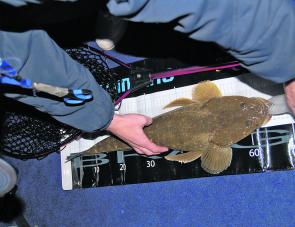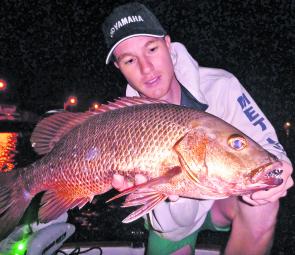For anglers getting out enjoying the sunshine and warmer conditions October offers, there are some respectable angling rewards to be reaped.
Estuarine, bay and offshore anglers will be treated to a broad array of angling targets including prime sportfish and table species. October is an awesome time to do a trip to Moreton Bay, the rivers or even the canals and creeks so let’s look at a few of the opulent options for October.
With water and air temperatures on the rise, mangrove jack activity will increase throughout the river and estuarine systems.
While jacks can be caught in numerous locations in these waters, it is usually the more heavily structured areas where the greater majority are encountered. I say encountered not caught because jacks are an aggressive and powerful sportfishing target that can bust off a complacent angler, or even an alert and skilled angler, in the blink of an eye. They will readily hit their prey on the return journey to their structure which leaves little time to react, pull the slack out of the line and put some serious hurt on the jack in an attempt to pry it away from its snaggy sanctuary.
Anything above a 50% capture to hook-up rate is a good outcome for most jack anglers.
As jacks will eat a broad array of baitfish and crustaceans, they will also attack a wide array of lures. Hardbodied minnows, lipless crankbaits, soft plastics (especially paddle-tails), surface offerings and numerous others can all work a treat. Fishing the lure well and getting it close to the structure where jacks lie in ambush mode is of highest priority.
Accurate casting is a must if you want the best opportunity of hooking a jack. This is the reason why the majority of serious jack anglers use baitcasting tackle with 15-30lb line to deliver their lures. However, quality spinning outfits can still cast accurately in the hands of experienced fishers and shouldn’t be disregarded totally.
Live baits work exceptionally well, with poddy mullet, herring, prawns and pike being some of the more popular offerings. These are usually pinned lightly on a 3/0-6/0 livebait or octopus pattern hook (sometimes on a twin hook snelled rig) with 30lb-50lb fluorocarbon or monofilament leader. Use just enough lead to keep your bait in the strike zone and be ready to react, strike and wind quickly when a jack hits.
Try around sunken mangrove banks, rock walls, concrete retaining walls, bridge and jetty pylons, pontoons and other prominent structure, especially that which alters the current flow or creates eddies adjacent to it. Areas where light shines on the water at night will attract baitfish and often jacks might be lurking in the general precinct.
I find that paddle-tail and crustacean profiled plastics fished on jigheads or the weedless snakehead rigs will allow you to fish the offering close to submerged structure, preferably rattling over it.
For pontoons, bridge pylons and other structure that is higher in the water column, bibbed minnow lures offer a great approach. Late afternoon, night and early morning sessions with surface offerings such as poppers and stickbaits will provide some knee-trembling strikes around eddies adjacent to structure and also areas where baitfish congregate, such as lighted areas in the canals and rivers.
Jacks are an awesome target and very palatable but remember to limit your catch of this iconic estuarine sportfish.
Another great Aussie sportfish is the threadfin salmon. We are fortunate in Southern Queensland to have an amazing fishery for this species, especially in the Brisbane River where they have been prominent captures for over a decade.
However, they have also spread to other systems such as the Caboolture River, Logan River, throughout areas of the Pumicestone Passage and other waterways over the years. The Brisbane River definitely offers the better concentrations of this species and it is very common to capture them when fishing this waterway. Even land-based anglers have worked out where and when it’s easiest to catch them on both baits and lures. The down-side of targeting threadies is that the larger specimens (which can exceed 120cm) don’t take well to handling and are best to be released boat-side without lifting them from the water.
Threadfin are spread right throughout the Brisbane River from the leads beacons at the mouth right up to Mount Crosby. The lower section of the river, from the Gateway Bridge down to the river mouth is probably the hardest hit by anglers but continues to produce some respectable captures on a regular basis.
Good offerings include an array of plastics and vibration baits, yet in certain areas you can also successfully use minnow lures, micro jigs, blades and even baitfish profiled flies.
Live baits including mullet, herring, pike and banana prawns are prime offerings and probably the easiest way for inexperienced anglers to get amongst a few threadies. Even the humble pilchard and other dead offerings can produce the goods at times.
One quality threadfin is more than enough for several meals so careful handling and release is recommended if we are to keep healthy stocks of threadfin in our waters.
There will still be quite a few quality snapper around for anglers fishing the numerous grounds within Moreton Bay. I often get some of the better specimens as the water is starting to warm as summer approaches.
The numbers are usually down a bit but the quality more than makes up for this most of the time. Additionally, while hopping plastics and vibration baits around the bay island fringes and the artificial reefs during October there is a good chance of tangling with other species such as sweetlip, tuskfish, school mackerel, estuary cod, flathead, tuna, bonito and numerous others.
The larger tides generally produce the better results but I have caught quality snapper during all sorts of tidal movements and moon phases.
The usual offerings, both natural and artificial, will work well during October however if the water is still fairly clear you may need to use more neutral coloured offerings and thinner leaders to produce strikes, especially in the shallower waters.
As outlined in the September issue, school mackerel can be reasonably prevalent in certain areas of Moreton Bay around this time of the year.
The eastern end of the Rous Channel is probably one of the more reliable spots however they can be fickle as to what stage of the tide they like to feed on in this area. Usually however, if you fish the last few hours of the run in and the first 2 hours of the run out then you should be able to secure a few. At times however it is like shooting fish in a barrel and every lure or bait put in the water is soon engulfed with vigour.
Try drifting pilchards rigged on ganged hooks or trolling lures to secure your result. The commercial sector troll small spoons (such as No.3 Halco Barra Drones) behind a paravane or trolling board however I regularly use deep diving minnow lures up to around 120mm in length.
Around the beacons in the northern bay, try jigging chromed slugs and slices or drifting ganged-hook rigged pilchards. I prefer the period around the change of the tide (either high or low) for this pursuit but mackerel can be caught at any time of the tide if there is baitfish present. If you have some success at one beacon and the bite subsides then go and try another for a while and then return to try again later.
Trolling deep diving minnow lures on tops of the flats out from Tangalooma and around Middle Bank can also be highly productive at times.
Another prized predator in Moreton Bay during October is the brutish cobia. I must admit to not having a lot of success on this species during the few trips I have put in to target them over the last couple of years but the early reports this year from further north have been fairly inspiring.
Large live baits are generally the best offering however large soft plastics, jigs and even trolled minnow lures will produce the goods in the right scenario. I like to use whiptails, larger demersal species (adhere to size limits), sand crabs and school mackerel for targeting cobia.
The areas around the beacons in the northern bay, Kianga Channel, Yellowpatch, artificial reefs and the shallow offshore reefs and coffee rock areas are all worth probing.
Usually I find if you catch one then you will get another soon after. The larger specimens are exceptional eating in my books and one quality specimen over 15kg will provide a huge amount of succulent fillets.
A prominent estuarine target during October is the humble flattie. These are available in increased numbers during this period because the larger females come inshore to breed, closely followed by hordes of smaller males.
While these females should be left alone to do their business, or returned to the water quickly if caught, the males make a good target for the estuarine angler. These can be taken on a huge array of lures and baits. Once you know their habits then targeting them can be predictable as you will generally have a good idea to where they are most likely to be lying in ambush mode.
Casting lures, such as soft plastics, vibration baits, flies, minnow lures, and working them over these areas is a successful technique.
Trolling is also a great way to find a flathead or two, especially for inexperienced anglers. This allows you to cover a sizeable area of water in a fairly short time. Once one flathead is found then trolling the same area repeatedly will often produce more captures.
When you do find a couple then take note of the type of terrain you are fishing and the stage of tidal movement as this will add another piece to the flathead jigsaw puzzle to help you improve future results.
A good strategy is to work the tops of the banks on the higher stages of tidal movement and the edges of the banks where they decline into the gutters and channels as the tide begins to fall. The mouths of creeks, channels and gutters are also prime areas on the falling tide.
Limit your catch of flathead and release the larger females, especially those over 75cm (as the law dictates) and this fishery will remain healthy for years to come.
In the same areas where you locate flatties, you are also likely to catch bream, whiting, tailor, trevally and other species on the same lures and baits, just to add a little variety to your day.
In addition to all these great targets, there will be some excellent opportunity for mud and sand crabs, longtail tuna, yellowtail kingfish, sweetlip, estuary cod and a host of other species during October.
With longer days and warmer conditions, anglers will need to be aware of the effects of the sun and temperature with sunburn, fatigue and dehydration being more likely than in recent months.
Overall however, it is a great time to be out on the water with warm days and nights and plenty of prime sportfishing targets and succulent species available. Hope you get to enjoy a day or two on the water sampling October’s opulent options.
Reads: 1116
A chunky Brisbane River flathead being measured before release.

Matt Mundy with another quality mangrove Jack taken on a deep diving minnow lure from a Gold coast Canal.

A quality decent lure fished from down near the mouth of the Brisbane River.




